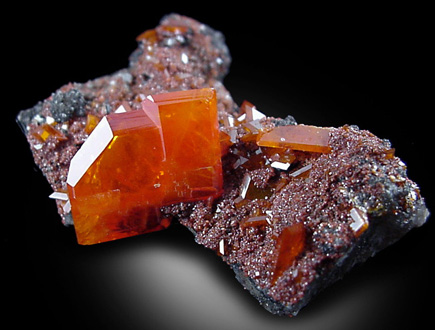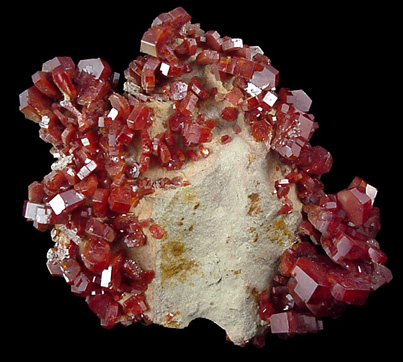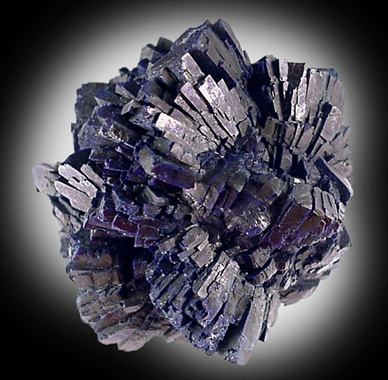
John Betts - Fine Minerals > Home Page > Educational Articles |

by John H. Betts, All Rights Reserved

1. Transfer image to computer - After all the images in a session are captured in the camera then transfer them to the computer. Every camera/computer combination is different, so the process will vary. Basically, copy the images from the memory of the camera into a directory/folder on the computer.
2. Make sure the computer monitor is properly adjusted - When image editing software is first installed there will be a routine to calibrate the computer monitor, often this is referred to as the Gamma. Make sure to go through this process, otherwise images may look great on your computer, but not on anybody else’s. If the monitor is set too dark, adjusted images will look good on your monitor, but they will be washed out on a "normal" monitor. If Photoshop is used for image editing it has an excellent Gamma calibration built in, as do most Macintosh computers. Unfortunately, not everyone calibrates their monitors so there is no control over what the viewer actually sees. In instances where color balance is critical the best alternative is to create a color print to send.
3. Open the image - This involves opening the directory/folder where the images are saved on the computer. Each image will be listed with a name like "MV1607.jpg". The characters before the dot are the file name. The "jpg" after the dot refers to JPEG file format. If the image editing software is properly installed, double-clicking on a file will open the program and open the image.

4. Crop the photo - The very first step is to closely approximate the final cropping of the image. A window is made around the image, after adjusting the boundaries to final position hit "enter" to complete the crop. Re-cropping can be done later, but eliminating extraneous background is an important first step. Also at this time the image can be rotated if the camera was set for a vertical image. Photoshop has a great cropping feature: the cropping window can be rotated to correct for camera misalignment saving an additional step.
5. Adjust levels - A very powerful tool in Photoshop is the image adjustment command called Levels. This command expands the dynamic range of the image to cover the full span of light to dark, which results in the best combination of brightness and contrast for most subjects. Basically it modifies the image so there is at least one black pixel in the image and one white pixel in the image and all other pixels somewhere in between. Most images can benefit from letting Photoshop automatically adjust the levels using the Auto Levels command. In certain instances though, the auto levels command will cause an unsatisfactory color shift. In this instance, simply undo and manually adjust the levels. The command cannot be fully covered in an introductory article like this, but is an important tool that should be learned and understood.
6. Adjust the Color Balance - Now is the time to make any adjustments in the color balance if necessary. In Photoshop there is a large selection of image adjustment tools or commands. For beginners, there is a nifty tool called Variations that displays the current image surrounded by variations on the image. Each variation is changing the color balance in one direction (i.e. more blue, more green, more magenta, etc.) Also there is a lighter and darker version of the image to choose from. The variations can also be controlled to make fine or coarse (lesser or greater) changes. It is a great tool for making any changes to the color balance, especially for novices.

7. Save the image - At this point the image is in a useable condition. Go to the command bar, click on "File" , then "Save As" and type in a file name, make sure the file type is set to JPEG format, then click "OK". The software will usually prompt for selecting an image quality value, a higher the number means higher quality but also larger file size. A value of 7 or 8 is best for master image files which should be kept at the high resolution in anticipation of any future use. For maximum image quality, save the image in TIFF format instead of JPEG. TIFF is an uncompressed file format, and unlike JPEGS, there is no image loss or degradation in quality due to compression.
8. Reduce resolution to useable size and save - A smaller, lower resolution, copy is needed of the master image if sending via email or posting to an online auction or e-commerce web site. In Photoshop, go to the command bar at the top, click on "Image" , then click on "Image Size". A dialog box will come up. There are two sections: Pixel Dimensions and Print Size. As discussed before, the Print Section is not important to image quality or file size, what matters is the length x width pixel count. Select "pixels" as units of measurement in the Pixel Dimension section (this only has to be done once, after that Photoshop will use the same settings.) A typical full size image may be 850 x 650 pixels depending on how the image was cropped and the quality of the camera. A good target size for emailing or Internet use is 400 x 300 pixels. Simply type in new values. Make sure the "Constrain Proportions" box at the bottom is checked, this will automatically adjust the width as the height is changed and vice versa to keep the proportions constant and prevent distortion. Then repeat step 8 to save the newly sized image. Remember to keep a master file at high resolution. Reducing resolution is irreversible - you cannot satisfactorily increase resolution from a low resolution image.
Photoshop has many sophisticated image editing tools to improve poor images or overcome difficult photographic situations. Many operations are very easy to do, including retouching out dust or lint, improving focus, selectively adjusting brightness, retouching backgrounds and removing artifacts of digital imaging like the edge effect. Very few commands must be learned to perform these tasks including: Image Adjustments, Magic Wand, Lasso, Dodge & Burn, Rubber Stamp, and Filters. Fortunately, the Photoshop users manual has an excellent tutorial on each of these tools, and it is possible to learn all of them in about 20-40 hours of practice. It is not within the scope of an introductory article like this to explain these operations in detail. However, some commonly performed techniques will be discussed.
Over the years this author tired of retouching dust out of the background or scratches on the black glass that support the mineral. As a result the author’s process ignores background completely and instead the background is added later during image editing. (See Figure 4.)
The specimen is posed, lighted, and the image is captured as described previously. After cropping the image and adjusting the levels, the part of the image surrounding the specimen is selected using various Photoshop tools. Most handy is the Magic Wand that selects similar pixels all at once. Also the Lasso tool can be used to manually grab the background part of the image. Once all the background has been selected any operations performed in Photoshop will only affect the background pixels, not on the mineral part of the image. Next the background area is filled using the Fill command with a solid background color, in this instance black. It is possible to stop at this point if the image looks acceptable. However, in the example here, the translucency in the crystal resulting from the white background when photographed, looks unnatural. By airbrushing in a white glow around the crystal the translucency looks more natural. Again, this is done with only the background pixels selected so nothing is enhanced on the mineral portion of the image.
|
|
|
|
|
Figure 4. Sequence of retouching an image. From left to right: A. Original image cropped with all extraneous lighting and photo props visible. B. The background dropped out in black. C. Diffuse halo added to the background. |
It is important to have the final image in mind when creating the initial image with the camera. If translucency of the crystals is the goal it is best to use a white background. Or if the specimen is opaque and final image will have a dark background with only a colored "glow" then it is best to shoot on black or other solid color.
Good images can be made of difficult to photograph specimens by using multiple images and combining them using Photoshop. For example, a close-up image where the depth of field is shallow. Two images can be captured, one where the matrix is in focus, the other where the crystals are in focus. By combining the focused parts of each image into one image a satisfactory final image can be created. The combining of various parts of images is extremely easy with image editing software.
© John H. Betts - All Rights
Reserved
Please support our sponsor
© John H. Betts - All Rights Reserved